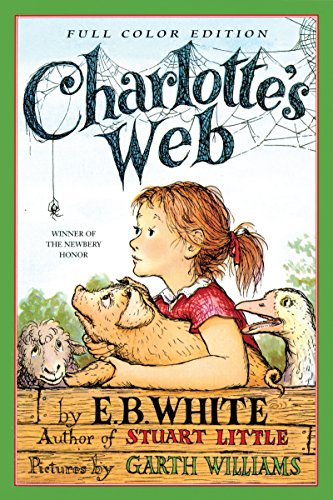
Book Details
Genre: Children, Fantasy, Drama
Formats: Paperback, Kindle
Ages: 6 to 10 years
Pages: 184
Publisher: Harper Collins
Buy From amazon India
Price: Rs 150 for paperback and Rs. 147.25 for kindle edition
Plot Synopsis
Charlotte's Web by E. B. White, is a story about the life of the animals on the farm as seen through the eyes of a pig named Wilbur.
Wilbur was born a runt and would have been put to death right away, if the kind hearted little Fern had not come to his rescue. Fern begged her father to let Wilbur live and promised to take care of him. Wilbur had many beautiful days in the sunlit woods as Fern's beloved pet, before Fern's father insisted on selling him.
Fern was very upset, but fortunately, her mother was able to suggest a compromise. Wilbur was sold to Fern's uncle Mr. Zuckerman, who was a farmer. He lived close by, and allowed her to visit Wilbur in the farm and watch him and the other animals.
Fern loved all the animals and spent hours silently watching them, enjoying the smells and activity in the barn. But poor Wilbur was upset by the sudden change in his lifestyle. Although he was thrilled to be so well fed, he missed his freedom, the outdoors, and a chance at exploring the world at large. He also felt lonely and friendless, being the solitary pig in the pen with a grouchy unfriendly rat being the only other occupant, or so he thought.
Wilbur's early upbringing with Fern resulted in him being naive of the harsh truths of farm life. So when he learned that he was being fattened to be slaughtered at Christmas time, he was frightened and shocked. But just around this time, he made an unlikely friend, someone who unknown to him, had been living right near him, all along.
The ways of his new friend disgusted him, but he also learned that underneath the tough exterior, his new friend was kind, loyal and intelligent.
Can Wilbur's resourceful new friend actually save him from the grisly fate that awaits him at Christmas? Read on to find out.
Highlights
Through beautifully nuanced characters, E. B White shares some uncomfortable and harsh truths of life in a firm, honest, yet gentle manner.
Change is an inevitable part of life, and yet it can be hard to accept and deal with. On several occasions the story demonstrates that with time one learns to adapt to change, and that the key to happiness is to make the most of the situation one finds oneself in. The story also shows that sometimes a deep understanding of the people around us, coupled with ingenuity, resourcefulness and perseverance allow us to take control of our life and steer it towards more pleasant circumstances.
The characters in the story are realistic with their shades of gray. Templeton the rat is the most obvious example. In spite of his generally sullen and selfish nature, he often comes through for his friends when they really need him. Wilbur, too initially misjudges his friend Charlotte for he evaluates her choices based on his own circumstances instead of trying to view life through her eyes.
The story presents many different attitudes to life through its wide variety of human and animal characters and shows how each of them suit the different personalities enabling them to lead fulfilling lives.
The warm illustrations by Garth Williams enhance the reading experience.
The story conveys that life is a jumble of emotions and circumstances, but it is possible to straighten out the messy yarn and weave something beautiful. The friends we pick up on this journey may sweeten every moment, or drive us to achieve the unimaginable. Either way, with them, we make memories we can cherish for a lifetime.
Charlotte is far more knowledgeable than Wilbur, and the author cleverly uses their conversations to introduce kids to uncommon or difficult words, therefore expanding their vocabulary.
In spite of the profound ideas conveyed by the story, the writing is lucid and light hearted. My favorite passage from the book is a where Wilbur expresses his annoyance with the phrase less than nothing through a series of logical statements. It goes like this:
I don't think there is any such thing as less than nothing. Nothing is the absolute limit of nothingness. It's the lowest you can go. It's the end of the line. How can something be less than nothing? If there were something less than nothing, then nothing would not be nothing, it would be something-- even though it's just a very little bit of something. But if nothing is nothing, then nothing has nothing that is less than it is.
Unflinchingly honest, yet delicately nuanced.
Thanks PlusMinus’N’More, for everything I learned from you about reviewing books.